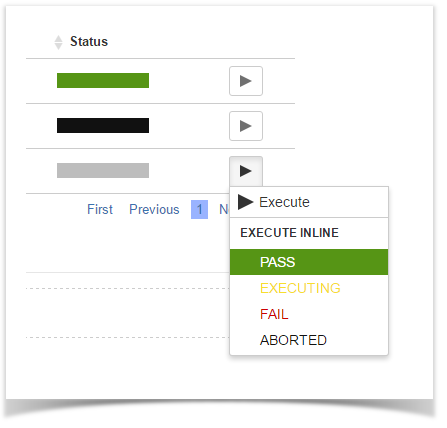Page History
...
| Info |
|---|
A Test Execution represents a task for running several Tests. It contains as many Test Runs as the number of Tests associated with it. To be precise, there is one Test Run per associated Test, in order to track the result for each Test. |
| Table of Contents |
|---|
What is stored in a Test Run
...
Depending on the original type of the Test associated with this Test Run, these are the fields are replicated in the Test Run.
| Manual Tests | Cucumber Tests | Generic Tests | |
|---|---|---|---|
| Test |
|
|
|
| linked Pre-Condition(s) |
|
|
|
Since a Test Run is related to the execution of a Test, obviously, it contains comments and information about linked defects and evidences (i.e., attachments).
...
Step 3: Click Run action to open the Execution page.
| Info | ||
|---|---|---|
| ||
This action may trigger some email notification(s) depending on your Xray settings. For more info on email notifications and how to set-up them, please have a look at Test Run Email Notifications. |
Execute Test Inline
To execute Test Runs Inline from the Test issue screen, this option must be enabled in the Xray administration page. The option for setting the Test Run status manually, without having to execute all Test Steps (or Examples in the case of Cucumber Tests), must also be enabled in the Xray administration page.
...
Step 2: Click the Execute button located in the last column of the Test Runs table and select one of the available statuses.
| Info | ||
|---|---|---|
| ||
This action may trigger some email notification(s) depending on your Xray settings. For more info on email notifications and how to set-up them, please have a look at Test Run Email Notifications. |
View Test Execution Details
...
If the Redirect To Execute Test Page option is selected, you will be redirected to the Execute Test page after the test execution is created.
Configure Test Run Columns
Xray provides the ability to configure columns for the Test Runs table. This configuration is specific to each user and can be restored to the default configuration defined in the Global Preferences page in Xray's administration.
Some columns may be be fixed and thus you won't be able to remove them from the table.
To configure columns for the Test Runs table,
Step 1: Go to the Test Runs table.
Step 2: Click on the Columns, select the dropdown that appears above the table in the top-right corner. A list of the current configure columns and all available columns appears.
Step 3: Add or remove columns by clicking the checkboxes next to each field.
Step 4: Click the Done button when finished or Cancel to abort this operation. The table refreshes with the configured columns.
Test Run-Specific Columns
The following columns are not Jira fields, but they represent information stored internally by Xray for Test Runs. You can also choose these columns for your layout.
Restoring Columns to Default Configuration
To restore columns in the Test Runs table to the default configuration,
Step 1: Open the Test Execution issue.
Step 2: Click on the Columns, select the dropdown that appears above the table in the top-right corner. A list of the current configure columns and all available columns appears.
Step 3: Click the Restore Columns link above the columns list. The table refreshes with the default configured columns.
Change Columns Order
To reorder columns in the Test Runs table,
Step 1: Open the Test Execution issue.
Step 2: Hover over the desired column header.
Step 3: Click on the column header and drag it to the desired position.


